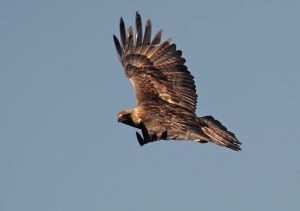 There are not many success stories in wildlife these days but there is one that may come as a surprise to many people as there has been a rise in the number of breeding golden eagles. The latest press release from the Royal Society for the Protection of Birds indicates a rise in the number of breeding pairs to a very encouraging 508 pairs in Scotland. This is a result of a survey co-funded by the RSPB and the Scottish Natural Heritage and the groundwork by a large number of people from organisations such as the Raptor Study Group. To my mind these numbers golden eagle pairs are significant as they indicate a rise in numbers that are thought to be present in the country from an historical point of view. It is also significant that, unfortunately, the new numbers of 508 pairs is the population for the entire UK. This is because there have been reports that the only resident golden eagle in England is thought to have died.
There are not many success stories in wildlife these days but there is one that may come as a surprise to many people as there has been a rise in the number of breeding golden eagles. The latest press release from the Royal Society for the Protection of Birds indicates a rise in the number of breeding pairs to a very encouraging 508 pairs in Scotland. This is a result of a survey co-funded by the RSPB and the Scottish Natural Heritage and the groundwork by a large number of people from organisations such as the Raptor Study Group. To my mind these numbers golden eagle pairs are significant as they indicate a rise in numbers that are thought to be present in the country from an historical point of view. It is also significant that, unfortunately, the new numbers of 508 pairs is the population for the entire UK. This is because there have been reports that the only resident golden eagle in England is thought to have died.
However, we in Scotland should not be complacent with the new figures as there are still a number of golden eagles being illegally killed in various areas. For example there are still parts of the eastern Highlands where there are no golden eagles breeding or present. By sheer co-incidence many of these vacant territories are on ground that is managed as red grouse moors primarily for shooting. In recent years a number of golden eagles fitted with satellite tags have mysteriously disappeared in eastern and western Highlands and all of them on grouse moors.
Many years ago I was active in the golden eagle surveys as I was responsible for eyries on a hill range near Inverness and another just south of Ullapool. I well remember one year’s visit to the hill range near Inverness as the nest was very intriguing. I had looked at this pair of golden eagle’s range for a number of years so I knew there were three nests of which the pair chose one each year. I had climbed up to the pairs favourite site and was disappointed to find that although the nest had been topped up with fresh twigs and fully lined there were no eggs. I presumed the clutch of eggs, two to three normally, had been taken by the notorious egg collectors. Just in case I climbed up to the other two eyries but they had not been touched which, I thought, just confirmed my egg collecting theory.
It was with a feeling of dismay that I climbed up to the top of the hill to admire the view and have a rest and I sank down into the deep heather. Then, after some time, I heard a call, not too far away, that sounded like a golden eagle chick but it was coming from the ground, in the heather! I had a good search and eventually found the nest with two golden eagle chicks but the nest was not on the usual cliff face but on the ground which I had never come across before. The two chicks were of a different size, as normal, as the incubation starts as soon as the first egg is laid. This means that one chick is smaller than the other and so gets the most food. This is alright if the food supply is good but in a poor year for food the larger, more demanding chick survives whilst the other, weaker, chick dies. It has been recorded that the larger chicks will often eat its sibling. A mysterious and intriguing nest indeed.
Tags: highland birds
